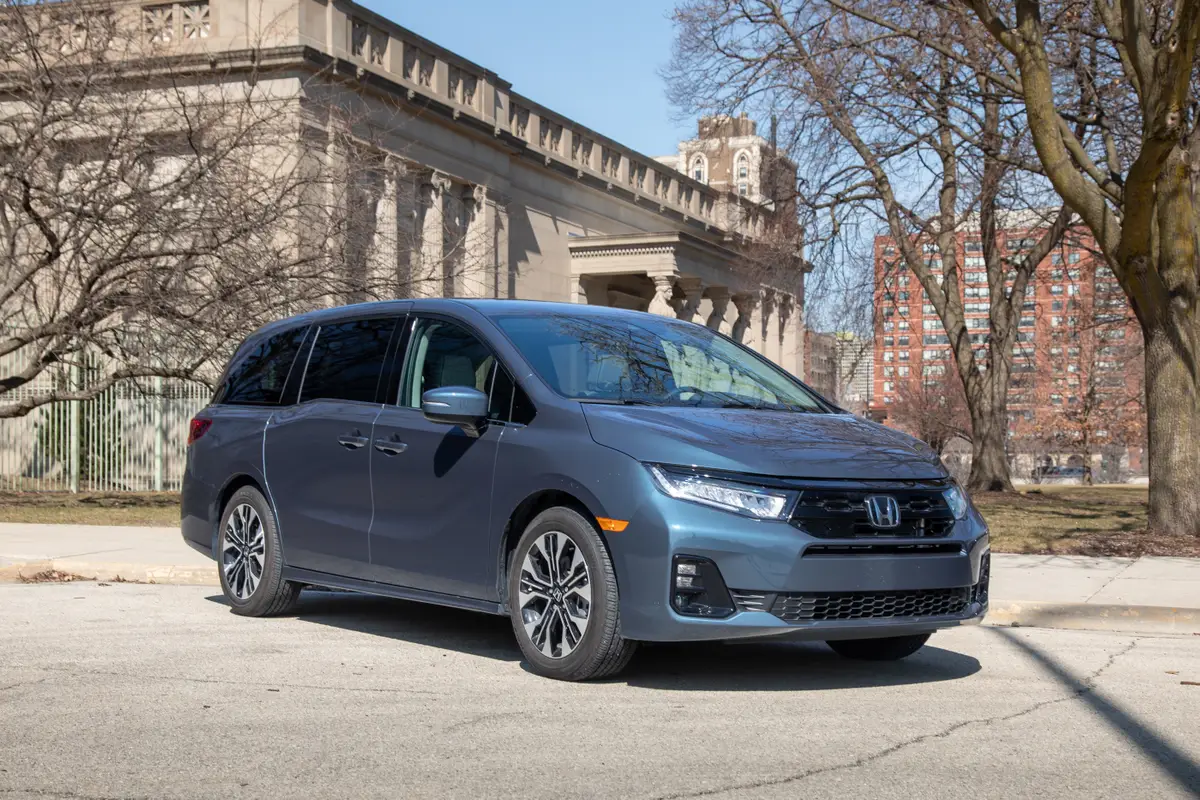Video: 2018 Honda Clarity Plug-In Hybrid: Review
By Cars.com Editors
November 13, 2018
Share
About the video
Plug-in hybrid electric vehicles are a strange phenomenon. Theoretically, they’re a good idea; the problem is that so many models have such a short electric range. That’s why, when an automaker seems to have gotten it right, we take notice.
Transcript
Plug-in hybrid electric vehicles are a strange phenomenon. Theoretically, they're a great idea.
You plug the car in, charge a battery pack, and then you get to drive a certain number of miles on electric power before a gas engine turns on and keeps you moving. The problem is that so many models of this description have such a short electric range. We're talking about in the teens of miles, or maybe the 20s. And that is why when an automaker seems to have done it right, we take notice. And that is the case with the Honda Clarity Plug-In Hybrid. Note that I'm talking about one type of Honda Clarity. There are two other versions. One runs on battery power alone, and another has a hydrogen fuel cell system. Those two are pretty limited in their appeal. The one with more broad appeal across the nation is the plug-in hybrid version. Now, before we go for a ride, let's talk about the numbers, which are really important. The EPA estimated electric vehicle range for the Clarity is 48 miles, which is pretty good. The Chevy Volt is just a little bit more at 53 miles, but here's the thing. Because of our driving history and the fact that the weather has been favorable, we've had temperatures in the 80s and 90s, we've been seeing projected ranges of 58.5 miles at the highest when the battery is full. And we are getting that. Now, if you have winter weather, and it's colder, or you drive more aggressively around hills, will that number be lower? Yes, and history suggests it might even be lower than the EPA estimate, but understand that that is going to be the case with any plug-in vehicle. Now, key to maximizing your range with any plugin is conditioning the cabin ahead of time, which is a fancy way of saying cooling it down or heating it up before you go driving. And that is because when you're driving in electric mode, all the power for heat and air conditioning comes from the battery, and that just steals your range. So it's best to pre-condition the cabin when it is still connected to the charging system, and you're using grid power. We were really pleased to see with the Clarity that it includes a key fob based system for turning on the air conditioning or heat remotely. And there's also a provision for it on the app. Now, the phone that we were provided didn't have a mobile plan, so we didn't get to test it fully, but it does have a fair number of features on it. It actually shows you more on it than you can see inside the car. If you buy a Clarity Plug-In Hybrid, you are going to want 240-Volt Level 2 charging, which is this unit here or another one like it that's currently plugged in, and I'll tell you why. Partly because when you go to pre-condition the cabin, you're getting five times more power that way. We tried to cool down the cabin of the Clarity sitting in the sun using the provided household voltage, 120-Volt system, and it just couldn't cut it. Likewise, if you are charging using this, you're adding about four to five miles of range for every hour of charging. So when the battery is empty, that's up to 12 hours, and that's just not fast enough. Now, if you get a Level 2 system that is capable of 30 amps or higher, then you will be able to charge the battery completely in about two and a half hours. You're adding about 20 miles of range for every hour of charging. It's well worth the investment. Overall, we're pretty impressed with the driving experience in the Clarity. It kind of recalls the Chevy Volt when it is in its electric mode, because it has pretty robust acceleration on electric power alone. And it's pretty linear in ways that hybrid cars often aren't. With a hybrid, sometimes the gas engine turns on, it turns off. It's a little jerky. It's not what your average car enthusiast really wants, but it is efficient. Now, because it can run in electric mode alone, no gas, it's much more natural and linear. Now one difference is in the Chevy Volt, even if you stand on the accelerator, it'll stay electric propulsion only. In this car, if you really gun it, it will turn the engine on for maximum power. For what it's worth, when I said you have to stand on it to trigger the gas engine, here in the flatlands where cars.com is headquartered, I drove a few days without turning on the gas engine, without even really thinking about it. So there is enough power for normal driving in electric only mode. There's actually a section of the gauge that's gray. It's almost like the red line on the tachometer, but in this case, it's the gray line. And if you keep the needle, or virtual needle, out of that area, the gas engine won't turn on. There's a definite difference in the feel of the drivetrain when you're in hybrid mode. Now hybrid mode means either you've activated hybrid mode to maintain your state of charging the battery, or the electric charge from plugging it into the wall is depleted, and you've got electric and gas. It's not quite as inconsistent as a regular gas/electric hybrid, but it is definitely not as linear and natural feeling as the car behaves when it is running on electric power alone. Now, there are some quirks, though, in this system, and one of them involves the braking, not the regular braking, which is actually pretty decent pedal feel. Not to be confused with a normal car, but when you drive a hybrid or a pure battery electric, you get regenerative braking. The brake pedal feels a little spongy. There's some of that here. No question. The issue is with the selectable regenerative breaking, which is something many electric or plug-in hybrid cars offer you, where you can change the amount that it decelerates when you lift off the accelerator. Now, the weird thing about this car is the way you activate a different level of regenerative breaking. And that is through hitting the shift paddle, what we usually see as a shift paddle. There's a negative here and a plus here. So you do this, and there are up to four steps. The problem is you have to do that every time. And when I say every time, if you're in the regular drive mode, you are driving forward, you hit it a few times. If you come to a stop, or if a few seconds go by, it defaults to where it was. It makes no sense whatsoever. I have not met anyone that likes this system. I would prefer if you just were able to set it, and it stayed where you put it. The only way that happens is if you activate the sport mode. In sport mode, the accelerator pedal is more sensitive. And if you set that deceleration for greater regeneration, it stays there, but there's a big difference between sporty driving and efficient driving, at least in the driver's mind. So I'd rather be able to just set the regeneration the way I want it in any mode, not in sport. Regarding the handling, I liked the balance in the car, the weight distribution. Bear in mind, it has an electric motor and a gas engine up front, a big heavy battery pack in the rear. That gives it a nice balance. Low center of gravity feels good. The steering feels actually quite good, but I would not call this a sports car, and necessarily even a sporty car. Typical of this type of vehicle, the weak link is the tires. They are designed for efficiency, so they don't have the greatest grip in the world. You can accidentally spin the tires on dry pavement. Once you get on to wet stuff, it's probably gonna happen a little bit more, but by and large, it's not a bad car to drive. Overall, we find the ride quality to be quite good in the Clarity. It's not soft, but it's not overly firm, pretty good comfort for the front seat and back seat occupants. In our opinion, the shortcomings of the Clarity are mainly about the multimedia system, which we really haven't liked that much in other Honda vehicles, especially earlier ones, because this model came out technically more than a year ago. It doesn't have the volume knob and tuning knob that have since been added. It's all a capacitive touch system. And it's actually pretty short on some of the neat graphics and details you get in a lot of plug-in, either plug-in hybrid or just purely battery electric vehicles. You do get very simple bar graphs like this one. There is the requisite. See, it's a little slow, stick with me, the requisite vehicle energy page, so you can tell how much range you have, electric versus gas. And that is repeated also in the instrument panel. But by and large, we're talking about what seemed like older graphics for what is a brand new car. And to that end, there's kind of a shortage of information from the charging system as well. There's a little green dot that glows when the car is charging, which is good to have, but you look at some other vehicles out there, and you can tell by the number of indicators, or the blinking or something, how full the battery is at a glance. In this car, you're just looking outside. You're seeing that it's either charging or it is not. You do get more information on the app, which is good, but if you have a full touchscreen system like this, why not have it here too? The Clarity plug-in hybrid's closest competitor is the Chevrolet Volt, with a V as in voltage, the plug-in hybrid. They're priced practically the same, just over $34,000 with destination, and eligible for a $7,500 tax credit. The range is longer on the Volt, but the combined miles per gallon, once the electricity is used up, is the same between the two cars at 42 miles per gallon. Pretty good there. Now I'm sitting in the best place to see one of the great advantages of this Clarity is that it's larger. It's got about two inches more leg room, almost an inch and a half more head room, just a larger vehicle overall. And ultimately, that can be useful for a family. I wish the seat were a little bit higher off the ground. My knees are kind of pointing up, which, unfortunately, is pretty common these days in cars of all types. Here's one claim to fame. The smartphone holder in the seat back. Now that's innovation. Now, one area where it might seem the Clarity has an advantage over the Volt is cargo volume, because the specs suggest that it has a few more cubic feet, but for what it's worth, the Volt is a hatchback. And there's always some inherent advantage there. Even though the battery pack is a little bit high, it does have folding back seats, which is good, so you can extend in. I'm gonna say it's probably a wash between the two models for versatility versus overall cargo volume. You can get a lot in here. It's just a kind of a strange shape. There's no question the Clarity has a lot to offer, especially if you wanna get decent electric range in your plug-in hybrid, which, let's be honest, if you're gonna get a car that can be plugged in, the more range you can get out of electric, the better. So in that regard, this plug-in hybrid makes a lot more sense than a lot of the vehicles on the market now, and a lot of the plug-in hybrids to come.
Featured stories

By Mike Hanley
April 21, 2025

By Cars.com Editors
April 21, 2025

2025 Honda Odyssey Review: Getting the Job Done

By Brian Normile
Road Test Editor
